搜索引擎论文
搜索引擎毕业论文
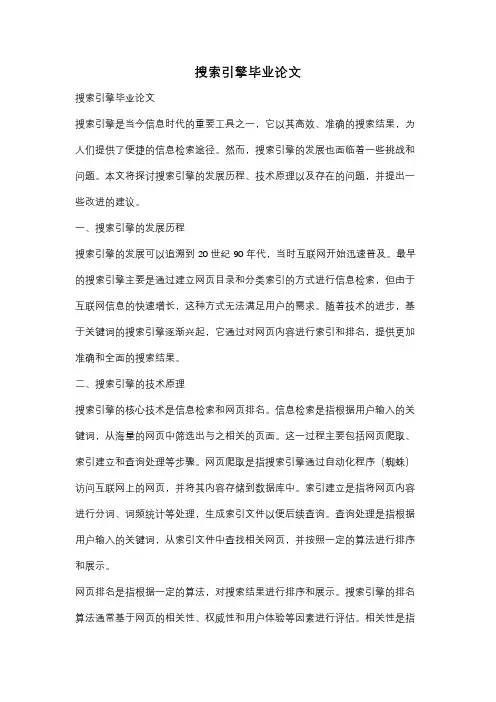
搜索引擎毕业论文搜索引擎毕业论文搜索引擎是当今信息时代的重要工具之一,它以其高效、准确的搜索结果,为人们提供了便捷的信息检索途径。
然而,搜索引擎的发展也面临着一些挑战和问题。
本文将探讨搜索引擎的发展历程、技术原理以及存在的问题,并提出一些改进的建议。
一、搜索引擎的发展历程搜索引擎的发展可以追溯到20世纪90年代,当时互联网开始迅速普及。
最早的搜索引擎主要是通过建立网页目录和分类索引的方式进行信息检索,但由于互联网信息的快速增长,这种方式无法满足用户的需求。
随着技术的进步,基于关键词的搜索引擎逐渐兴起,它通过对网页内容进行索引和排名,提供更加准确和全面的搜索结果。
二、搜索引擎的技术原理搜索引擎的核心技术是信息检索和网页排名。
信息检索是指根据用户输入的关键词,从海量的网页中筛选出与之相关的页面。
这一过程主要包括网页爬取、索引建立和查询处理等步骤。
网页爬取是指搜索引擎通过自动化程序(蜘蛛)访问互联网上的网页,并将其内容存储到数据库中。
索引建立是指将网页内容进行分词、词频统计等处理,生成索引文件以便后续查询。
查询处理是指根据用户输入的关键词,从索引文件中查找相关网页,并按照一定的算法进行排序和展示。
网页排名是指根据一定的算法,对搜索结果进行排序和展示。
搜索引擎的排名算法通常基于网页的相关性、权威性和用户体验等因素进行评估。
相关性是指网页与用户输入的关键词的匹配程度,权威性是指网页的信誉和影响力,用户体验是指用户对搜索结果的满意度。
搜索引擎通过对这些因素进行综合评估,为用户提供最符合其需求的搜索结果。
三、搜索引擎存在的问题尽管搜索引擎在信息检索方面取得了显著的成就,但仍然存在一些问题。
首先,搜索结果的准确性和可信度有待提高。
由于互联网上存在大量的垃圾信息和虚假信息,搜索引擎往往难以准确判断网页的质量和真实性。
其次,搜索引擎的个性化推荐功能存在一定的局限性。
虽然搜索引擎可以根据用户的搜索历史和兴趣偏好,为其提供个性化的搜索结果,但这种推荐往往容易陷入信息过滤的困境,导致用户接触到的信息变得单一和局限。
搜索引擎
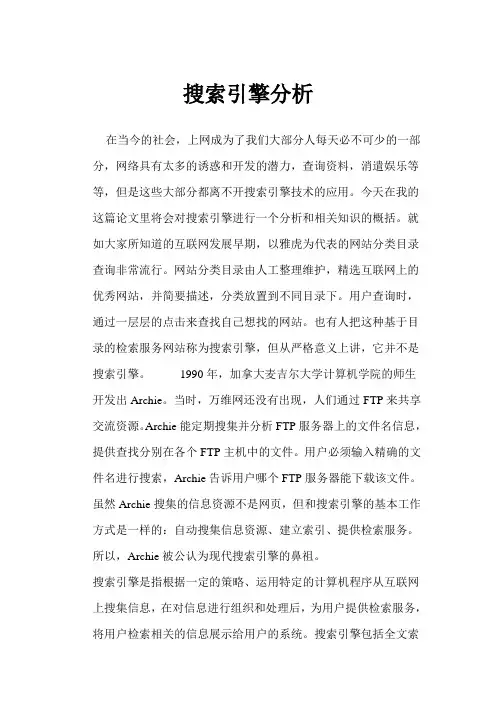
搜索引擎分析在当今的社会,上网成为了我们大部分人每天必不可少的一部分,网络具有太多的诱惑和开发的潜力,查询资料,消遣娱乐等等,但是这些大部分都离不开搜索引擎技术的应用。
今天在我的这篇论文里将会对搜索引擎进行一个分析和相关知识的概括。
就如大家所知道的互联网发展早期,以雅虎为代表的网站分类目录查询非常流行。
网站分类目录由人工整理维护,精选互联网上的优秀网站,并简要描述,分类放置到不同目录下。
用户查询时,通过一层层的点击来查找自己想找的网站。
也有人把这种基于目录的检索服务网站称为搜索引擎,但从严格意义上讲,它并不是搜索引擎。
1990年,加拿大麦吉尔大学计算机学院的师生开发出Archie。
当时,万维网还没有出现,人们通过FTP来共享交流资源。
Archie能定期搜集并分析FTP服务器上的文件名信息,提供查找分别在各个FTP主机中的文件。
用户必须输入精确的文件名进行搜索,Archie告诉用户哪个FTP服务器能下载该文件。
虽然Archie搜集的信息资源不是网页,但和搜索引擎的基本工作方式是一样的:自动搜集信息资源、建立索引、提供检索服务。
所以,Archie被公认为现代搜索引擎的鼻祖。
搜索引擎是指根据一定的策略、运用特定的计算机程序从互联网上搜集信息,在对信息进行组织和处理后,为用户提供检索服务,将用户检索相关的信息展示给用户的系统。
搜索引擎包括全文索引、目录索引、元搜索引擎、垂直搜索引擎、集合式搜索引擎、门户搜索引擎与免费链接列表等。
百度和谷歌等是搜索引擎的代表。
那么搜索引擎将来的发展方向和发展的前景又是如何?我们就先从以下的各类主流搜索引擎先进行一个大致的分析。
1.全文索引全文搜索引擎是当今主要网络搜素时所应用的搜索引擎,在网络上也是大家所熟知的,比如google和百度都是我们平时经常使用的。
它们从互联网提取各个网站的信息,建立起数据库,并能检索与用户查询条件相匹配的记录,按一定的排列顺序返回结果。
根据搜索结果来源的不同,全文搜索引擎可分为两类,一类拥有自己的检索程序,俗称“蜘蛛”程序或“机器人”程序,能自建网页数据库,搜索结果直接从自身的数据库中调用,上面提到的Google 和百度就属于这种类型;另一类则是租用其他搜索引擎的数据库,并按自定的格式排列搜索结果,如Lycos搜索引擎。
语文命题作文议论文《如何正确使用互联网搜索引擎》高中生作文范文初中生作文范文
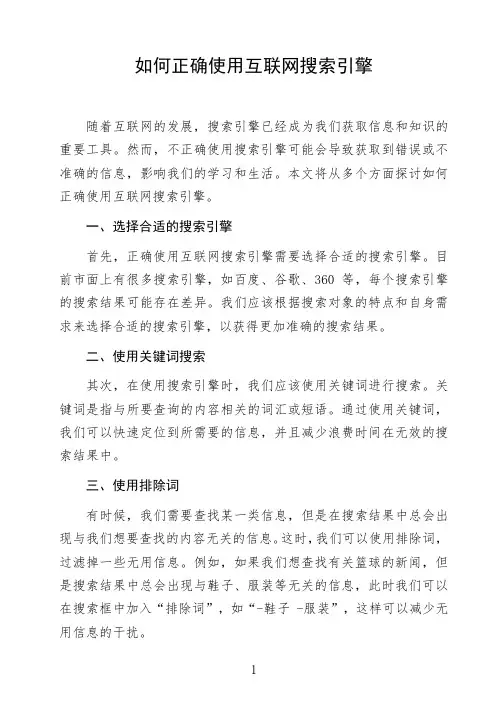
如何正确使用互联网搜索引擎随着互联网的发展,搜索引擎已经成为我们获取信息和知识的重要工具。
然而,不正确使用搜索引擎可能会导致获取到错误或不准确的信息,影响我们的学习和生活。
本文将从多个方面探讨如何正确使用互联网搜索引擎。
一、选择合适的搜索引擎首先,正确使用互联网搜索引擎需要选择合适的搜索引擎。
目前市面上有很多搜索引擎,如百度、谷歌、360等,每个搜索引擎的搜索结果可能存在差异。
我们应该根据搜索对象的特点和自身需求来选择合适的搜索引擎,以获得更加准确的搜索结果。
二、使用关键词搜索其次,在使用搜索引擎时,我们应该使用关键词进行搜索。
关键词是指与所要查询的内容相关的词汇或短语。
通过使用关键词,我们可以快速定位到所需要的信息,并且减少浪费时间在无效的搜索结果中。
三、使用排除词有时候,我们需要查找某一类信息,但是在搜索结果中总会出现与我们想要查找的内容无关的信息。
这时,我们可以使用排除词,过滤掉一些无用信息。
例如,如果我们想查找有关篮球的新闻,但是搜索结果中总会出现与鞋子、服装等无关的信息,此时我们可以在搜索框中加入“排除词”,如“-鞋子 -服装”,这样可以减少无用信息的干扰。
四、使用引号和括号有时候,我们需要查询一些短语或者固定词组,这时候可以使用引号将整个短语或词组括起来进行搜索。
例如,如果我们想要查询“人民银行”的信息,可以在搜索框中输入“人民银行”,这样可以快速地筛选出相关的信息,而不必再去一个个排除掉与人民银行无关的信息。
另外,在搜索框中使用括号也可以实现类似的功能。
五、检查搜索结果来源和可靠性最后,在使用搜索引擎时,我们还需要检查搜索结果的来源和可靠性。
有些不负责任的网站可能会发布虚假信息或误导性内容,因此我们需要通过多个来源对比、验证,以确保获取到的信息是真实可信的。
总之,正确使用互联网搜索引擎需要选择合适的搜索引擎、使用关键词、排除词、引号、括号等方式进行搜索,并且注意检查搜索结果的来源和可靠性。
各类搜索引擎的搜索语法应用论文
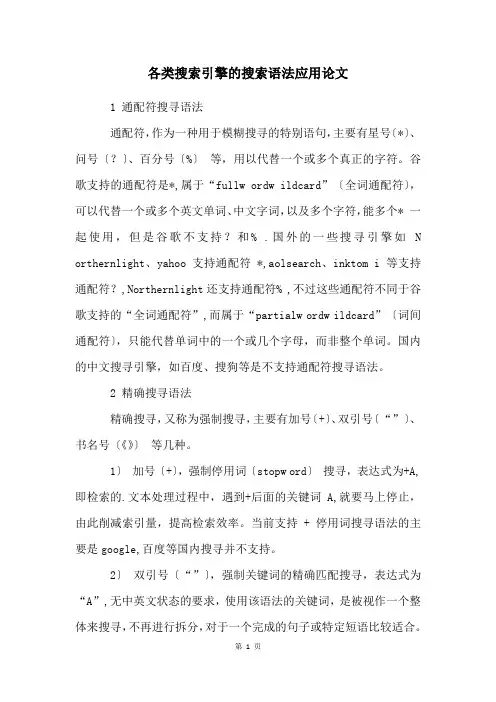
各类搜索引擎的搜索语法应用论文1 通配符搜寻语法通配符,作为一种用于模糊搜寻的特别语句,主要有星号〔*〕、问号〔?〕、百分号〔%〕等,用以代替一个或多个真正的字符。
谷歌支持的通配符是*,属于“fullw ordw ildcard”〔全词通配符〕,可以代替一个或多个英文单词、中文字词,以及多个字符,能多个* 一起使用,但是谷歌不支持?和% .国外的一些搜寻引擎如N orthernlight、yahoo 支持通配符 *,aolsearch、inktom i等支持通配符?,Northernlight还支持通配符% ,不过这些通配符不同于谷歌支持的“全词通配符”,而属于“partialw ordw ildcard”〔词间通配符〕,只能代替单词中的一个或几个字母,而非整个单词。
国内的中文搜寻引擎,如百度、搜狗等是不支持通配符搜寻语法。
2 精确搜寻语法精确搜寻,又称为强制搜寻,主要有加号〔+〕、双引号〔“”〕、书名号〔《》〕等几种。
1〕加号〔+〕,强制停用词〔stopw ord〕搜寻,表达式为+A,即检索的.文本处理过程中,遇到+后面的关键词A,就要马上停止,由此削减索引量,提高检索效率。
当前支持 + 停用词搜寻语法的主要是google,百度等国内搜寻并不支持。
2〕双引号〔“”〕,强制关键词的精确匹配搜寻,表达式为“A”,无中英文状态的要求,使用该语法的关键词,是被视作一个整体来搜寻,不再进行拆分,对于一个完成的句子或特定短语比较适合。
作为一种基本搜寻语法,被大多数搜寻引擎所支持。
3〕书名号〔《》〕,强制图书、报刊、音乐、影视等名称的精确匹配搜寻,表达式为《A》,谷歌、百度、360、有道等对此支持,而必应、雅虎、搜狗、搜搜并不支持。
3 规律搜寻语法规律搜寻就是在检索两个或以上的关键词时,需要用到布尔规律运算。
详细语法主要有“规律与”、“规律或”、“规律非”,分别表示AN D、O R、N O.1〕“规律与”,表示要同时包含两个或以上的关键词,操作符有空格、加号〔+〕、and号〔〕等几种,表达式分别是A B、A+B、AB,多数搜寻引擎是将空格作为“规律与”的操作符,而谷歌支持空格和加号〔+〕,百度支持空格和and号〔〕。
17个学术论文搜索引擎
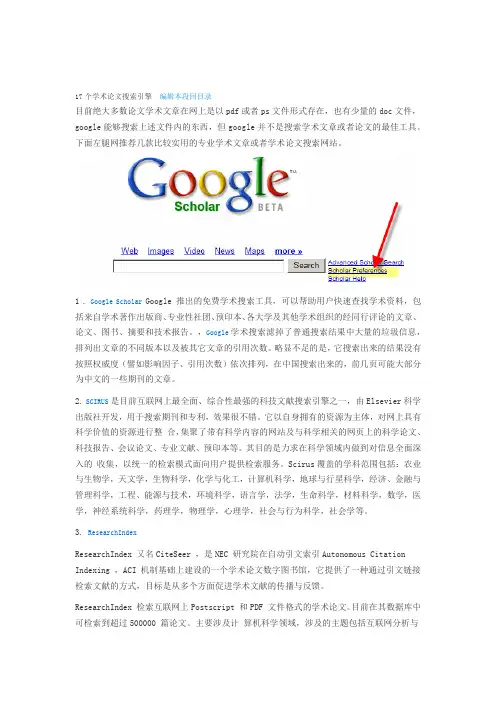
17个学术论文搜索引擎编辑本段回目录目前绝大多数论文学术文章在网上是以pdf或者ps文件形式存在,也有少量的doc文件,google能够搜索上述文件内的东西,但google并不是搜索学术文章或者论文的最佳工具。
下面左腿网推荐几款比较实用的专业学术文章或者学术论文搜索网站。
1 . Google Scholar Google 推出的免费学术搜索工具,可以帮助用户快速查找学术资料,包括来自学术著作出版商、专业性社团、预印本、各大学及其他学术组织的经同行评论的文章、论文、图书、摘要和技术报告。
,Google学术搜索滤掉了普通搜索结果中大量的垃圾信息,排列出文章的不同版本以及被其它文章的引用次数。
略显不足的是,它搜索出来的结果没有按照权威度(譬如影响因子、引用次数)依次排列,在中国搜索出来的,前几页可能大部分为中文的一些期刊的文章。
2. SCIRUS是目前互联网上最全面、综合性最强的科技文献搜索引擎之一,由Elsevier科学出版社开发,用于搜索期刊和专利,效果很不错。
它以自身拥有的资源为主体,对网上具有科学价值的资源进行整合,集聚了带有科学内容的网站及与科学相关的网页上的科学论文、科技报告、会议论文、专业文献、预印本等。
其目的是力求在科学领域内做到对信息全面深入的收集,以统一的检索模式面向用户提供检索服务。
Scirus覆盖的学科范围包括:农业与生物学,天文学,生物科学,化学与化工,计算机科学,地球与行星科学,经济、金融与管理科学,工程、能源与技术,环境科学,语言学,法学,生命科学,材料科学,数学,医学,神经系统科学,药理学,物理学,心理学,社会与行为科学,社会学等。
3. ResearchIndexResearchIndex 又名CiteSeer ,是NEC 研究院在自动引文索引Autonomous Citation Indexing ,ACI 机制基础上建设的一个学术论文数字图书馆,它提供了一种通过引文链接检索文献的方式,目标是从多个方面促进学术文献的传播与反馈。
论文写作中的学术写作的常见学术搜索引擎与数据库
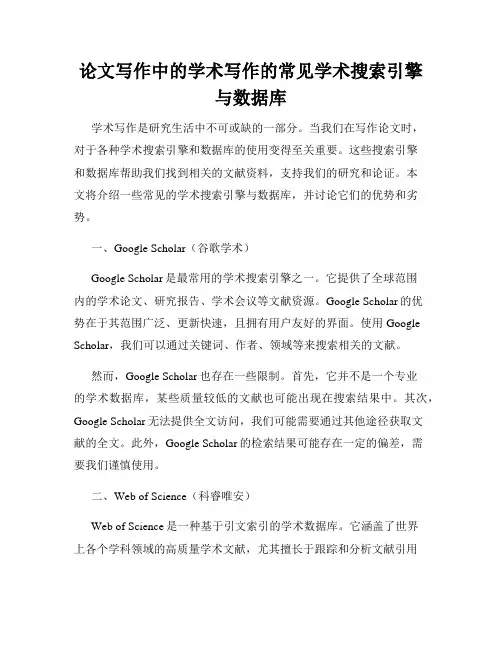
论文写作中的学术写作的常见学术搜索引擎与数据库学术写作是研究生活中不可或缺的一部分。
当我们在写作论文时,对于各种学术搜索引擎和数据库的使用变得至关重要。
这些搜索引擎和数据库帮助我们找到相关的文献资料,支持我们的研究和论证。
本文将介绍一些常见的学术搜索引擎与数据库,并讨论它们的优势和劣势。
一、Google Scholar(谷歌学术)Google Scholar是最常用的学术搜索引擎之一。
它提供了全球范围内的学术论文、研究报告、学术会议等文献资源。
Google Scholar的优势在于其范围广泛、更新快速,且拥有用户友好的界面。
使用Google Scholar,我们可以通过关键词、作者、领域等来搜索相关的文献。
然而,Google Scholar也存在一些限制。
首先,它并不是一个专业的学术数据库,某些质量较低的文献也可能出现在搜索结果中。
其次,Google Scholar无法提供全文访问,我们可能需要通过其他途径获取文献的全文。
此外,Google Scholar的检索结果可能存在一定的偏差,需要我们谨慎使用。
二、Web of Science(科睿唯安)Web of Science是一种基于引文索引的学术数据库。
它涵盖了世界上各个学科领域的高质量学术文献,尤其擅长于跟踪和分析文献引用关系。
Web of Science的优势在于其高度可靠和权威性,能够提供精确的引用数据和影响因子等指标,帮助我们评估文献的学术价值。
然而,Web of Science也存在一些限制。
首先,它需要订阅才能使用,有时会在使用上造成一定的困扰。
其次,Web of Science只涵盖了部分学科领域的文献,对特定学科的覆盖可能较为有限。
因此,在使用Web of Science时,我们需要结合其他数据库的信息来进行综合检索。
三、PubMed(美国国立卫生研究院文献数据库)PubMed是一个专注于生命科学和医药领域的学术搜索引擎。
它收录了大量与生物医学相关的文献资源,包括医学期刊、研究报告、病例研究等。
搜索引擎论文
The Design and Realization of Open-Source SearchEngine Based on NutchGuojun Yu 1Xiaoyao Xie *,2Zhijie Liu 3Key Laboratory of Information and Computing Science of Guizhou ProvinceGuizhou Normal University Network CenterGuiyang,Chinaxyx@ (corresponding author:Xiaoyao Xie)Abstract —Search engines nowadays are becoming more andmore necessary and popular in surf surfing ing the Internet Internet..However,how these search engines like G oogle or B aidu work works s is unknown to many people.This paper,through a research into Open-source search engine Nutch,introduces how a common search engine works.By using Nutch,a search engine whichbelongs to Guizhou Normal University University’’s website is designed and at last,through the improvement of Nutch Nutch’’s sorting algorithm and experiment experiment,,it can be found that Nutch is very suitable for working in home-search home-search..Keywords-Search Engine Engine;;Nutch Nutch;;Lucene Lucene;;Java Open Source Source;;I.I NTRODUCTIONNutch is an open-source search engine based on LuceneJava,which is an open-source information retrieval library supported by the Apache Software Foundation for the search and index component,providing a crawler program,an Index engine and a Query engine[1].Nutch consists of the following three parts:(1)Pages collection (fetch).The program of collecting pages,by timely collection or incremental collection,chooses the URLs,through which pages are to be visited and then fetched to the local disk by the crawler.(2)Creating index.The program of creating index converts the pages or other files into the txt-document,divides them into segments,filters some useless information and then,creates and assists indexes which are composed by some smaller indexes based on key words or inverted documents.(3)Searcher.The program of searcher accepts user’s query words through segmentation and filtering and then divides them into groups of key words,according to which correspondent pages are matched in treasury index.Then,it puts the matches in order by sorting and returns the results to the users.The overall framework of Nutch is listed infigureFigure 1II.ACKGROUNDOn account of the fact that there are so many sites under Guizhou Normal University’s website,not only the pages but also some other resources like doc,pfd are needed to be indexed.In this sense,adding the text analyzer module to the design based on Nutch’s framework,the whole design is composed by the crawler design module,the text analyzer module,the index module and the search module as listed in figure2.Figure2III.HE PROCESS OF THE WORKFLOWA.An Analyzsis of the Nutch’CrawlerA Web crawler is a kind of robot or software agent.In general,it starts with a list of URLs to visit,called the seeds.When visiting these URLs,the crawler identifies all the hyperlinks in the page and adds them to the list of URLs to visit,called the crawl frontier [2].URLs from the frontier are recursively visited according to a set of policies.See figure3referenced from[2].Figure3There are four factors affecting the crawler’s ability referenced by [3]:Depth:the depth of the downloadtopN:the amount of page hyperlinks before the downloadThreads:the threads which the download programmer usesDelay:the delay time of the host visiting The work process of the Nutch’s Crawler includes four steps as follows:1.Create the initial collection of the URL.2.Begin the Fetching based on the pre-defined Depth,topN,Threads and Delay.3.Create the new URL waiting list and start the new round of Fetching like in Figure 4referenced by [8].4.Unite the resources downloaded in the local disk.B.Page Voice EliminationAfter getting the content,the pages include a lot of tags and other ad information.It is necessary to eliminate these spasms and get the effective document.Here the program must complete two missions.See figure 6referenced by [9].1.Analyze the inner html pages’basis information and distinguish the structure of the pages.2.At the same time,eliminate the voice of the page and avoid the same results.Figure 5Under the directory of the Nutch workspace,there are some folders listed as follows:Crawldb Directory:This folder stores the URLs downloaded and the time when they were downloaded.Linkdb Directory:This folder stores the relationship between the URLs,which is form the parsed results after the download.Segments:This folder stores the pages and resources that the crawler has fetched.The amount of the directories is related to the depth of the crawler’fetch.For much better management,the folders are named in their time.C.Creating the IndexAt the heart of all search engines is the concept of indexing,which means processing the original data into a highly efficient cross-reference lookup in order to facilitate rapid searching.Nutch’s Documents are analyzed and disposed by Lucene.Lucene is a high performance,scalable Information Retrieval (IR)library [4].It lets you add indexing and searching capabilities to your applications.Lucene is a mature,free,open-source project implemented in Java.Figure 6referenced by [6]displays the framework of the Lucene.And there are three steps to complete the work referenced by [5]-[6].Figure6The first step:Document ConvertingLucene does not care about the source of the data,its format,or even its language as long as you can convert it to text.This means you can use Lucene to index and search data stored in files,web pages on remote web servers, documents stored in local file systems,simple text files, Microsoft Word documents,HTML or PDF files,or any other formats,from which you can extract textual information.Figure7referenced by[6]tellingmore.Figure7The second step:AnalysisOnce you have prepared the data for indexing and have created Lucene Documents populated with Fields,you can call Index Writer’s add-Document(Document)method and hand your data off to Lucene to index.When you do that, Lucene first analyzes the data to make it more suitable for indexing.To do so,it splits the textual data into chunks,or tokens,and performs a number of optional operations on them.For instance,the tokens could be lowercased before indexing to make searches case-insensitive.Typically it’s also desirable to remove all frequent but meaningless tokens from the input,such as stop words(a,an,the,in,on,and soon)in English text.An important point about analyzers is that they are used internally for fields flagged to be tokenized.Documents such as HTML,Microsoft Word,XML contain meta-data such as the author,the title,the last modified date,and potentially much more.When you are indexing rich documents,this meta-data should be separated and indexed as separate fields.The third step:Storing the IndexAn inverted index(also referred to as postings file or inverted file)is an index data structure storing a mapping from content,such as words or numbers,to its locations in a database file,or in a document or a set of documents,in this case allowing full text search.The inverted file may be the database file itself,rather than its index.It is the most popular data structure used in document retrieval systems.With the inverted index created,the query can now be resolved by jumping to the word id(via random access)in the inverted index.Random access is generally regarded as being faster than sequential access.The main Classes which achieve three steps listed as follows:Index Writer,Directory,Analyzer,Document, and Field.D.The Disposal of the Chinese Words SegmentationA major hurdle(unrelated to Lucene)remains when we are dealing with various languages,handling text encoding. The Standard Analyzer is still the best built-in general-purpose analyzer,even accounting for CJK characters. However,the Sandbox CJK Analyzer seems better suited for Chinese Words analysis[6].When we are indexing documents in multiple languages into a single index,using a per-Document analyzer is more appropriate.At last,under the directory of the Nutch workspace, there are some folders which store the index listed as follows:Indexes:stores individual index directories.Index:stores the last directory according to the Lucene’s format,which is combined by some individual indexes.E.The Design and Realization of the Searching ModuleSearching is the process of looking up words in an index to find documents where they appear.The quality of a search is typically described using precision and recall metrics[7].Recall measures how well the search system finds relevant documents,whereas precision measures how well the system filters out the irrelevant documents. However,we must consider a number of other factors when thinking about searching.Support for single and multi-term queries,phrase queries,wildcards,result ranking,and sorting is also important as a friendly syntax for entering those queries.Figure7shows the process of the searching.Pretreatment means carrying on text treatment. Segmentation through the class Query Parser and mixing a term in accordance with the Lucene format are two examples.The main classes which achieve these functions are listed as follows:Index Search,Term,Query,Term Query, Hits.F.Sorting Search ResultsSome common search Sorting models are Boolean logic model,Fuzzy logic model,Vector logic model and Probability searching model.In some applications we mainly use vector logic model which calculates the weighted parameters through the TF-IDF method.In this process,through calculation from the key words and the document’s relativity,we can get the value of the relativity between the key words and each document.And then,we sort these values,putting the document which meets the need(the value is higher)forward to the user,But this model has some limits:First,Web has mass data.The page includes a lot of insignificant and iterant messages which affect the information that users really want.The model cannot deal with these messages well.Second,the model does not take the links into account.In fact,the other goal of the search engine is to find the page which users often visit.Through the page the search engine could decide the importance of links of another page,like Page Rank.Lucene’s sorting model is improved based upon vector model,listed as follows:Lucene sorting algorithm[6]:score_d=sum_t(tf_q*idf_t/norm_q*tf_d*idf_t/ norm_d_t)score_d:Document(d)’score.sum_t:Term(t)’summation.tf_q:The square root of t’s frequence.tf_d:The square root of t’s frequence in d.idf_t:log(numDocs/docFreq_t+1)+1.0。
搜索引擎论文
搜索引擎论⽂所谓搜索引擎,就是根据⽤户需求与⼀定算法,运⽤特定策略从互联⽹检索出制定信息反馈给⽤户的⼀门检索技术。
当代,论⽂常⽤来指进⾏各个学术领域的研究和描述学术研究成果的⽂章,简称之为论⽂。
搜索引擎论⽂1 [摘要]随着新媒体的迅猛发展,新媒体与传统媒体融合趋势越来越明显,信息资源的整合性也越来越强。
搜索引擎作为检索信息的有效⼯具,正发挥着越来越重要的作⽤。
企业也开始利⽤搜索引擎作为市场营销的重要渠道。
搜索引擎市场在中国正不断发展壮⼤。
本⽂回顾了搜索引擎营销在中国的发展历程,指出了搜索引擎营销市场当前的现状、问题以及对策,并对搜索引擎市场的发展趋势做出简要的分析。
[关键词]市场营销搜索引擎营销 SEM 新媒体传播 ⼀、搜索引擎营销发展历程 搜索引擎营销的发展是紧随搜索引擎的发展⽽发展的。
1994年,以Yahoo为代表的分类⽬录型搜索引擎相继诞⽣,并逐渐体现出⽹络营销价值,于是搜索引擎营销思想开始出现。
新的检索技术不断改进,使搜索引擎营销策略不断向着针对性更强、更精准的⽅向发展。
1.⾃然搜索引擎营销阶段 我国在 20xx年之前的搜索引擎主要靠⼈⼯编辑分类⽬录为主,搜索引擎营销需要做的⼯作包括⽹站描述,准备关键词等基本信息,免费提交给各个搜索引擎,并保持跟踪。
⼀旦提交成功,就基本不需要对 META标签等进⾏修改了,因为搜索引擎收录的⽹站信息等内容不会因为⽹站的修改⽽随之改变。
2.简单搜索引擎营销阶段 我国在20xx年之前,搜索引擎营销是以免费分类⽬录登陆为主要的⽅式。
20xx年到20xx年期间,由于出现了按点击付费(Pay-per-click)的搜索引擎关键词⼴告,带来了收费问题,加上⽹络经济环境因素,搜索引擎营销市场进⼊了调整期,传统⽹络分类⽬录的推⼴作⽤⽇益减弱,甚⾄有⼈预⾔其将消失。
20xx年后期开始,以Google为代表的第⼆代搜索引擎渐成主流。
⽹站建成后⽆需⼈⼯提交,于是,基于⾃然检索结果的搜索引擎优化开始得到重视。
中国知网论文
中国知网论文
中国知网是一个在线的学术搜索引擎,提供包括学术论文、学位论文、会议论文等多种学术资源。
它是中国最大的学术文献资源库之一,收录了丰富的学科领域的学术研究成果。
中国知网论文可以通过关键词搜索、分类浏览等方式进行获取。
论文的检索结果通常以列表形式呈现,每条结果包括论文的标题、作者、摘要等相关信息。
用户可以通过阅读论文的摘要来初步了解论文的内容,若有需求,还可以查看论文的全文。
中国知网论文的质量较高,经过学术机构的审核和审稿。
由于中国知网收录了国内大量的学术期刊和会议论文,因此用户可以找到各种学科领域的优质论文。
同时,中国知网还提供了论文推荐和学术订阅等服务。
用户可以根据自己的兴趣和需求,获取相关领域的最新研究成果,并通过订阅功能实时获取最新论文的更新。
总之,中国知网论文是一个非常有价值的学术资源库,为广大科研工作者和学生提供了方便的学术资源获取渠道。
通过使用中国知网,用户可以快速找到并获取到自己需要的优质学术论文,促进学术研究的进行和学术交流的深入。
基于网络爬虫的搜索引擎设计与实现—毕业设计论文
本科毕业设计题目:基于网络爬虫的搜索引擎设计与实现系别:专业:计算机科学与技术班级:学号:姓名:同组人:指导教师:教师职称:协助指导教师:教师职称:摘要本文从搜索引擎的应用出发,探讨了网络蜘蛛在搜索引擎中的作用和地住,提出了网络蜘蛛的功能和设计要求。
在对网络蜘蛛系统结构和工作原理所作分析的基础上,研究了页面爬取、解析等策略和算法,并使用Java实现了一个网络蜘蛛的程序,对其运行结果做了分析。
关键字:爬虫、搜索引擎AbstractThe paper,discussing from the application of the search engine,searches the importance and function of Web spider in the search engine.and puts forward its demand of function and design.On the base of analyzing Web Spider’s system strtucture and working elements.this paper also researches the method and strategy of multithreading scheduler,Web page crawling and HTML parsing.And then.a program of web page crawling based on Java is applied and analyzed.Keyword: spider, search engine目录摘要 (1)Abstract (2)一、项目背景 (4)1.1搜索引擎现状分析 (4)1.2课题开发背景 (4)1.3网络爬虫的工作原理 (5)二、系统开发工具和平台 (5)2.1关于java语言 (5)2.2 Jbuilder介绍 (6)2.3 servlet的原理 (6)三、系统总体设计 (8)3.1系统总体结构 (8)3.2系统类图 (8)四、系统详细设计 (10)4.1搜索引擎界面设计 (10)4.2 servlet的实现 (12)4.3网页的解析实现 (13)4.3.1网页的分析 (13)4.3.2网页的处理队列 (14)4.3.3 搜索字符串的匹配 (14)4.3.4网页分析类的实现 (15)4.4网络爬虫的实现 (17)五、系统测试 (25)六、结论 (26)致谢 (26)参考文献 (27)一、项目背景1.1搜索引擎现状分析互联网被普及前,人们查阅资料首先想到的便是拥有大量书籍的图书馆,而在当今很多人都会选择一种更方便、快捷、全面、准确的方式——互联网.如果说互联网是一个知识宝库,那么搜索引擎就是打开知识宝库的一把钥匙.搜索引擎是随着WEB信息的迅速增加,从1995年开始逐渐发展起来的技术,用于帮助互联网用户查询信息的搜索工具.搜索引擎以一定的策略在互联网中搜集、发现信息,对信息进行理解、提取、组织和处理,并为用户提供检索服务,从而起到信息导航的目的.目前搜索引擎已经成为倍受网络用户关注的焦点,也成为计算机工业界和学术界争相研究、开发的对象.目前较流行的搜索引擎已有Google, Yahoo, Info seek, baidu等. 出于商业机密的考虑, 目前各个搜索引擎使用的Crawler 系统的技术内幕一般都不公开, 现有的文献也仅限于概要性介绍. 随着W eb 信息资源呈指数级增长及Web 信息资源动态变化, 传统的搜索引擎提供的信息检索服务已不能满足人们日益增长的对个性化服务的需要, 它们正面临着巨大的挑战. 以何种策略访问Web, 提高搜索效率, 成为近年来专业搜索引擎网络爬虫研究的主要问题之一。
- 1、下载文档前请自行甄别文档内容的完整性,平台不提供额外的编辑、内容补充、找答案等附加服务。
- 2、"仅部分预览"的文档,不可在线预览部分如存在完整性等问题,可反馈申请退款(可完整预览的文档不适用该条件!)。
- 3、如文档侵犯您的权益,请联系客服反馈,我们会尽快为您处理(人工客服工作时间:9:00-18:30)。
搜索引擎原理之我见
搜索引擎(Search Engine)是指根据一定的策略、运用特定的计算机程序从互联网上搜集信息,在对信息进行组织和处理后,为用户提供检索服务,将用户检索相关的信息展示给用户的系统。
搜索引擎包括全文索引、目录索引、元搜索引擎、垂直搜索引擎、集合式搜索引擎、门户搜索引擎与免费链接列表等。
说到搜索引擎,中国都不会陌生的引擎就是百度、搜狗和谷歌,刚开始谷歌在中国站绝大部分市场,自从李彦宏的百度一出,百度就蒸蒸日上,直接把谷歌赶出了中国,其中在百度中,只有输入Google相关的关键词,Google才可能排在前面,输入其他这些场合用词,Google 连采取对应的SEO百度的策略都没有,自然就不可能在百度中获得多关键词排名了。
所以,百度给google每天带去的流量是非常少的。
搜狗也是后来开发的。
说到百度,就想起一句耳闻能祥的话:有事找度娘。
从这句话中就可以看出现在百度在网民心中的分量,已经是一种依赖,不可缺少的一部分。
市场几乎占尽了中国市场,当然这也是百度自己的努力,搜索起来效率及其高,不然也不会到了让网民不能依赖的地步。
搜索引擎比较出名的一个名次就是蜘蛛,搜索引擎是通过一种特定规律的软件跟踪网页的链接,从一个链接爬到另外一个链接,像蜘蛛在蜘蛛网上爬行一样,所以被称为“蜘蛛”也被称为“机器人”。
搜索引擎蜘蛛的爬行是被输入了一定的规则的,它需要遵从一些命令或文件的内容。
搜索引擎是通过蜘蛛跟踪链接爬行到网页,并将爬行的数据存入原始页面数据库。
其中的页面数据与用户浏览器得到的HTML是完全一样的。
搜索引擎蜘蛛在抓取页面时,也做一定的重复内容检测,一旦遇到权重很低的网站上有大量抄袭、采集或者复制的内容,很可能就不再爬行。
搜索引擎将蜘蛛抓取回来的页面,进行各种步骤的预处理。
最后呈现我们看到的想要的东西。
百度搜索引擎拥有目前世界上最大的中文搜索引擎,总量超过3亿页以上,并且还在保持快速的增长。
百度搜索引擎具有高准确性、高查全率、更新快以及服务稳定的特点,能够帮助广大网民快速的在浩如烟海的互联网信息中找到自己需要的信息,因此深受网民的喜爱。
Google 的使命是整合全球范围的信息,使人人皆可访问并从中受益。
Google 目前被公认为全球最大的搜索引擎,它提供了简单易用的免费服务,用户可以在瞬间返回相关的搜索结果。
在访问Google 主页时,您可以使用多种语言查找信息、查看新闻标题、搜索超过10 亿幅的图片,并能够细读全球最大的Usenet 消息存档。
百度和谷歌相比,最大的优势就是制造中文的搜索引擎,从而吸引了大量网民的喜爱,其中百度贴吧是众搜索引擎中的一个特色,贴吧是网民闲谈的地方,具有开放性。
百度百科算是一种抄袭,我听说过一个国际的百科叫维基百科,不过百度百科有些创新,更符合中国网民使用。
总的来说,搜索引擎是当代网民不可或缺的一部分,方便了人的生活。
